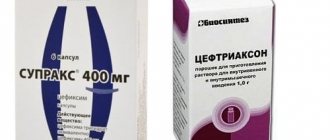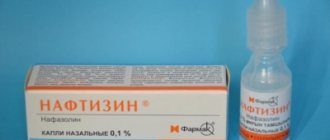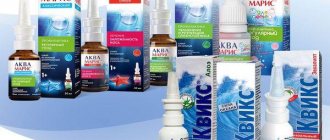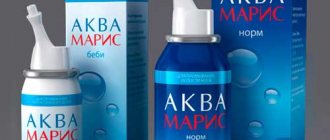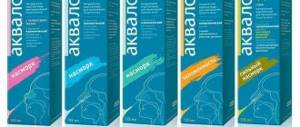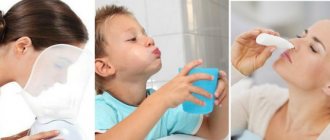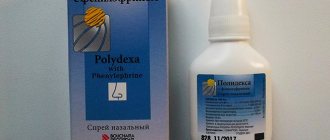How to dilute sea salt to rinse a child’s nose
Hello, my dear readers!
Rinsing the nose with saline is a uniquely effective procedure for everyone. It helps with rhinitis, relieves allergies, and is capable of many other good things. But here’s the problem: teaching a child to rinse his nose with salt water is so difficult! But it is children, often sick creatures, who need this skill the most!
What to do? How to rinse a child’s nose with saline solution, with benefit, but without tears and hysterics? At what age can a child master this almost magical skill, and how to teach him? About all this - in this material.
How is this procedure useful?
Here are just a few of its obvious advantages:
- the nasal mucosa is moistened, and the moistened mucous membrane is more protected from dangerous microbes and bacteria;
- the nose is mechanically cleansed with salty water, and from “bottles”, and from dust particles, and from all kinds of bacteria and viruses.
- during the procedure, mucus accumulated in the nose is eliminated, and breathing is restored;
- swelling goes away, inflammation is relieved, the condition of adenoids is alleviated;
- the risk of allergies is minimized;
- with a runny nose, the general condition is alleviated, and the illness goes away faster;
- this also makes children’s sleep more restful;
- the procedure can be easily done independently, at home;
- it is completely safe and is suitable even for children under one year old.
There is another obvious advantage of irrigating children's noses with water! This is a great way to wean your baby from poking around there.
The fact is that children, picking their noses, are simply trying to clear them of crusts that interfere with breathing. But there is no need to pick at clean noses, and it’s simply not interesting. By the way, pediatricians assure that this habit is not just bad, but also dangerous.
After all, a baby can damage the mucous membrane with a nail and easily cause an infection!
Who should not do this and when?
Despite all the advantages, this procedure has several contraindications. And it is very important for you, as parents, to know about them:
- neoplasms of various kinds - on the nasal mucosa;
- otitis;
- frequent nosebleeds;
- crooked nasal septum.
If you are not sure about the curvature of the septum, or the presence of neoplasms in your child, be sure to visit an otolaryngologist. It is this specialist who must give you the go-ahead to carry out the procedure.
How often should this be done?
So, doctors say that a healthy child, to prevent various troubles, can do this procedure (irrigation with saline solution or water with salt) once a day. It's best in the morning, before breakfast.
If the child is already sick or rhinitis develops, then it is advisable to repeat the procedure 2 to 4 times a day. It is best to do it an hour after a meal.
3 ways for children of different ages
Naturally, the procedure will differ and depend on the age of the child. It is more difficult for a one-year-old baby to pour liquid into the spout and then clean it than for a 6-year-old preschooler.
There are three main technologies:
- This procedure can be done on infants (at 3 months and 10 months), as well as at 1 year. Lay your baby on his back and gently place 1 drop of saline solution into each small nostril. Now wait 2 minutes - the salty liquid will dissolve the crusts in the nose. Now remove the contents of the spout with an aspirator. An aspirator is a kind of pear, sold in pharmacies and stores for babies.
- At 2 years old everything will be a little easier, and you can do without an aspirator. Tilt the baby's head to the side. Pour the saline solution into a bulb or pipette. Insert the tip into the nostril and pour out the solution. Repeat with the other nostril. Then ask your baby to gently blow his nose (not sharply, closing his nostrils one at a time and keeping his mouth slightly open). Children can be taught to blow their nose even at 2 years old, this has been proven by many children and parents. It is even more convenient to use ready-made salt sprays based on sea water. With them the procedure will be even faster and easier.
- School-age children are more conscientious. You can explain to them in detail why all this is needed. And teach how to irrigate your nose with liquid yourself - using a pear, a special rubber “teapot” (sold in pharmacies) or a bottle with a long nozzle. You can also use a regular syringe. The technology is the same as in the previous paragraph. Older children can also use sea water sprays, which are sold in ready-made form in pharmacies. They are convenient because you can use them not only at home, but also anywhere else.
+1 difficult, but effective
There is another way to rinse your child’s nose with saline solution at home. However, it is suitable for children 2 years and older. At the same time, I believe that this is one of the most effective methods. At one time he helped me get rid of sinusitis. When the doctors unanimously insisted that it was impossible to do without a “puncture”.
Differences
So, how is this method different from others?
Firstly, the depth of rinsing. Yes Yes! In fact, this is no longer moisturizing or irrigating the nasal mucosa, but thorough rinsing. Not only the nose, but also the nasopharynx!
Secondly, for this method a syringe, bulb or syringe will not be enough. For example, I usually use a wide mug (400 g). But it is better to take a wide and deep bowl. So that it is convenient for the child to immerse his nose in it.
Procedure technique
To this mug of warm water, add a teaspoon of salt (without the top) so that the nasal mucosa is comfortable. Now invite your child to play a funny game “nose drinks water.” I recommend playing it yourself first. To understand the process itself. And then play together with the baby. To do this, close one nostril with your index finger.
Then, bend over and immerse the other open nostril in the saline solution. Meanwhile, slowly begin to inhale salt water through your open nostril.
Don't be afraid, you won't choke. Because gradually the water from the nose will enter the nasopharynx, and then into the mouth. Therefore, you will spit it out.
At the same time, exhale not very sharply through the nose. You will get rid of not only the solution in it, but also a lot of unnecessary things! This way you will understand that drinking water through your spout is quite safe. And teach this to your child.
If your nose is stuffy, start rinsing with the nostril that is freer. You can wash it twice. But then you definitely need to try to draw in another saline solution. And rinse it.
When rinsing, you should never blow your nose, even while pinching one nostril. Because this can lead to ear inflammation. You just need to exhale sharply through both nostrils and everything will be fine. To clean your nose well, you need to take more than one exhalation.
The procedure can be repeated many times 5-10 times. But do it slowly, without haste. In this case, you need to constantly add warm water and add salt to it (or immediately prepare a lot of saline solution). So that you can grab it with your nose.
Of course, everything depends on the severity of the disease. However, I am sure that this particular method can wash even the maxillary sinuses. Hence, clean them in a safe way. But after such washing you can go outside no earlier than 15 minutes. When your nose is dry.
Homemade saline solution
Of course, you can irrigate children’s noses with ready-made saline solution or sea water from a pharmacy. But if the pharmacy is far away, you can make this liquid yourself at home! To this end, I would like to offer a recipe for liquid for self-production from Dr. Komarovsky.
To do this, take a glass of warm, clean water and a teaspoon of salt. Thoroughly dissolve the salt in the water, and then strain the liquid thoroughly. In such a solution, the ratio of water and salt will be ideal - it is 0.09%.
Life story
My cousin was an extremely sickly child when she was a child. So, almost every month she had either a runny nose, or a cough, or even all together. As a result, breathing problems resulted in severe snoring. The girl grew up, but did not become healthier.
And then one day she got a new attending physician, a very experienced and wise man. And he advised his sister to rinse her nose with salt water! He also came up with a convincing argument, he said something like: “Snoring is not only harmful, but because of it your husband will someday run away from you!
Start rinsing your nose with salt water every night. And soon you will stop snoring.” The sister was very impressed by this “threat” and actually began to regularly rinse her nose. You won’t believe it, but after 3 months she got rid of both frequent rhinitis and the ability to make noise at night!
So, dear parents! Now you know how to rinse your child’s nose with saline solution correctly. Do this, don’t be lazy, and then your babies’ noses will definitely be fine! Share this article with your friends via social networks and like it if you found it useful. And don’t forget to subscribe to the channel, there’s a lot of interesting things ahead! Health to you and your children!
Source: https://dou99.ru/nos/kak-razvesti-morskuyu-sol-dlya-promyvaniya-nosa-rebenku
Flushing procedure using an irrigation system
Before rinsing your nose with the Aquamaris irrigation device, you need to pour one packet of salt into a watering can-teapot, it is included in the kit or purchased separately, diluted with boiled water. It is important to monitor the temperature; the liquid should not be cold or hot, thereby preventing unpleasant manifestations.
Then the following actions are performed:
the patient stands over the bathtub, basin or sink, leaning slightly forward;
turn their head to the side;
the tip of the watering can is tightly applied to the nostril, then an inhalation is made, the breath is held;
tilt the watering can so that the healing solution flows into the nostril (it will flow out of the second nostril);
then you need to blow your nose to remove any remaining fluid, without changing the position of your head;
straighten up and blow their nose, return to their original position and turn their head in the other direction;
the procedure is repeated again from the second nostril.
When the process is completed, the device is washed with cold water and dried well.
This method can be used to rinse the noses of children from five to six years old and adults. Since water does not enter the nose under pressure, the possibility of it entering the patient's ear canal and causing otitis media is prevented.
Sea salt for nasal rinsing
Among the techniques designed to treat a runny nose, rinsing the nose with sea salt is considered effective and safe. It is recommended even for kids.
The benefits of sea salt
To understand why a positive result is observed when using sea salt to rinse the nose, it is advisable to study the composition.
The presence of iodine in large quantities in the structural formula provides antiseptic, wound-healing, and antibacterial effects. Thanks to this element, hormonal balance is regulated.
It contains other elements important for life:
- magnesium, which has a beneficial effect on the heart and nervous system;
- calcium, necessary to strengthen bones;
- selenium, which helps reduce the development of malignant tumors;
- copper, iron are elements that play an important role in the process of hematopoiesis.
Using sea salt to rinse your nose can help get rid of pathogens.
Indications for rinsing
You should rinse your nasal passages with salt at home for the following diseases:
- frontal sinusitis;
- rhinitis;
- sinusitis.
To avoid unpleasant consequences during the development of ARVI, it is advisable to resort to salt procedures at the first symptoms. They alleviate the condition if swelling of the mucous membranes is observed, causing nasal congestion.
Preparation of the solution
To make a healing solution of sea salt, you need to ensure the quality of the raw materials. Caution is required if purchasing a variety of sea salt oriented for baths.
Important! For this purpose, salt is purchased in packages indicating the necessary information about the product, which should not contain foreign impurities or additional components.
A solution for rinsing the nose of different concentrations is prepared, based on specific needs.
Weak solution
Before diluting sea salt to obtain a low concentration rinsing solution, it is advisable to boil the water in advance. For 500 ml you will need to add sea salt (a teaspoon), stir until completely dissolved and cool.
You should rinse your nasal passages twice with this solution during the day when the first signs of a cold appear.
Attention! The liquid must be warm, so it should be warmed up before each procedure.
Concentrated solution
More often the problem arises of how to make a solution of higher concentration that can eliminate mucus from the nasal cavity. For these purposes, sea salt will require 2 teaspoons. Dissolve with boiled water (one liter).
It is advisable to use such a solution (heated) to cleanse the nasal passages no more than once a day. The same liquid is used to gargle an inflamed throat.
For sinusitis
To alleviate the condition of a patient with sinusitis, dilute half a teaspoon of the base ingredient in 200 ml of boiled water.
With lemon
Lemon juice mixed with sea salt (a teaspoon) helps with swelling. Before preparing the healing liquid, cool boiled water (200 ml) to 30°C, in which the prepared mixture is diluted. Instill 3-4 drops up to three times a day.
Solution for a child
To cleanse the nose of children, only pure high-quality sea salt (a quarter of a teaspoon) is diluted in 300 ml of boiled water heated to 40°C. Stir until completely dissolved. It is advisable to additionally strain the liquid through double sterile gauze. If discomfort is observed, you can further dilute the solution.
Carrying out the washing procedure
You need to know how to properly rinse your nose with a prepared solution based on sea salt. Compliance with a sequence of simple actions is a condition for alleviating the condition and curing a runny nose.
- Blow your nose thoroughly, freeing the nasal cavities from mucus as completely as possible.
- If there is severe congestion with a runny nose, it is advisable to first apply vasoconstrictor drops and then blow your nose.
- Tilt your head to the side and use a syringe to pour a warm solution, diluted according to all the rules, into the upper nostril. In this case, fluid should flow freely from the lower nostril.
- Repeat with a tilt in the other direction.
When using sea salt for a runny nose that is just beginning, you can prepare a weak solution and pour it into a not very deep plate. They tilt their face and close one nostril with their finger, while the other one draws in the liquid, holding their breath. Open the second nostril, turn the head, allowing the solution to flow out calmly.
There are special devices in the shape of a teapot with a long spout that can easily fit into the nostril. When you tilt your head and pour the solution into the upper nostril, the liquid should flow out from the lower.
You can purchase a convenient Aqua Maris
, which will make the washing procedure easier even for small children.
For frequent rhinitis and frontal sinuses, it is advisable to purchase the Dolphin
.
Use it in an inclined position strictly according to the instructions.
Attention! After rinsing in any way, the final step is to clear the nose of any remaining liquid. To do this, you should blow your nose.
Recommendations for pregnant women
Many medications are contraindicated for pregnant women during colds, so the use of saline nasal rinsing is often recommended.
In the later stages, it is difficult to bend over to carry out the procedure, so instillation of the solution is used.
To do this, you need to tilt your head back in a supine position and inject liquid into your nostrils from a pipette. You don't need to get up right away. This will allow the solution to be distributed throughout the entire nasal cavity. The final stage after rising is blowing your nose.
Childhood
Difficulties may arise when solving the problem of how to rinse a baby’s nose so as not to cause him discomfort.
For children under 4 years of age, it is more convenient to use a pipette. The child should lie on his back. Slightly tilting his head back and turning it a little to the side, inject a portion of the solution into the upper nostril. After 30 seconds, tilt your head to the other side and treat the second nostril.
This position of the head will prevent the rapid penetration of liquid into the mouth, and the child will not experience any discomfort.
For older children, you can use a small rubber bulb and rinse over a basin, tilting your head to an optimally comfortable position.
When treating a child’s nose with sea salt, make sure that his mouth is open.
Types of drugs from the Aquamaris series
There are the following types of this drug.
Aquamaris is ok. Its composition is the same as that of the classic product, but it is enclosed in a pressurized metal bottle. It does not contain additional substances. The volume of bottles can be fifty, one hundred and one hundred fifty ml. It should be noted that the larger the volume, the lower the price will be. But here the choice is made by the patient himself.
Aquamaris baby. This drug has the same composition as the previous one, there is distilled and sea water, but it is intended for children. He only has one package - fifty milliliters. The bottle is equipped with a tip for a child's nose. The instructions for the drug indicate that they need to rinse their noses starting from the age of two.
Aquamaris for newborns. The name itself already suggests that it is intended for the youngest patients. The volume of the bottles is only ten milliliters. The bottle does not have a spray dispenser, which is very good, as it allows it to be administered to babies without any discomfort. The composition contains seventy percent ordinary water and thirty percent sea water.
Aquamaris plus. This product is available in glass containers of thirty milliliters. The bottle has a plastic injection tip. By pressing, the product is injected into the nasal passage. This product has a slightly different composition. It contains seventy-five percent water, twenty-five percent sea water, and one gram of dexpanthenol. This substance is a derivative of vitamin B5, which makes it possible to achieve additional effectiveness in the effects of the drug. All this improves immunity and also stimulates a more persistent response to bacterial invasion.
Aquamaris Strong. This type contains only sea water, without the addition of distilled water. It is intended to be sprayed into the nose to cause the outflow of fluid. This drug is more concentrated than others and therefore should never be used to rinse the nose. It is produced in bottles of thirty milliliters. It is an alternative to vasoconstrictors.
Aquamaris Classic. Its composition is the same as that of other types: ordinary water and sea water. Thirty milliliter bottles. Used to fight viruses and bacteria during a runny nose.
Aquamaris Throat. This remedy is used to treat the throat. Its composition is entirely from sea water. In addition, it contains various trace elements and salts. Thirty milliliter bottles.
Aquamarie Sens. The drug is used to combat allergens. Ingredients: ectoine, salt, water. It is ectoine that is a substance that can cope with allergens and eliminate symptoms. In pharmacies it can be found in glass bottles of twenty milliliters.
Aquamaris oto. It is used to treat the pinna and inner ear. The composition contains purified water and sea water. This drug is sold in bottles of one hundred milliliters.
All means are equally effective.
Indications for use
Nasal rinsing with Aquamaris allows you to cleanse the nasal passages and sinuses, protect and moisturize the mucous membrane, so they can be used directly to treat nasal diseases or to prevent ARVI. The main indications for prescribing the drug are:
- the need for additional moisturizing of the mucous membrane during a long stay in a dry room;
atrophic rhinitis, in which crusts form;- runny nose as a result of an allergic reaction of the body;
- treatment of the mucous membrane after surgery;
- prevention of colds during an epidemic;
- hygiene procedures for the nasal cavity for adults and children.
One of the most common indications for which the drug is prescribed is sinusitis. With this disease, Aquamaris (drops or spray) can be effective both as an independent remedy and as a drug that ensures maximum effectiveness of other prescriptions. Treatment with Aquamaris can replace punctures.
Analogues of the drug are other products based on sea water, which can replace Aquamaris, if necessary. These remedies include: Humer, Physiomer, Nazomarin, Marimer, etc.
The use of Aquamaris is a safe and simple way to treat and prevent nasal diseases. The product has no contraindications, which makes it indispensable in the treatment of certain categories of patients, and a special device will help achieve maximum effectiveness of the procedure.
